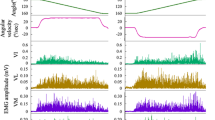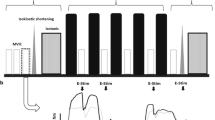Abstract
This study investigated the effects of the knee joint angle and angular velocity on hamstring muscles’ activation patterns during maximum eccentric knee flexion contractions. Ten healthy young males (23.4 ± 1.3 years) performed eccentric knee flexion at constant velocities of 10, 60, 180, and 300 deg/s in random order. The eccentric knee flexion torque and the surface electromyographic (EMG) activity of the biceps femoris (BF), semitendinosus (ST), and semimembranosus (SM) muscles were measured. The results of torque during 10 deg/s were lower than the faster velocities. No significant change was found in eccentric torque output and the EMG amplitude with change in the faster test velocities, although those values showed a decreasing tendency as the knee approached extension. Furthermore, the EMG amplitude of the BF decreased significantly as the knee approached extension, although the EMG activity of the ST and SM remained constant. These results suggest that the neural inhibitory mechanism might be involved in decreasing in maximal voluntary force and hamstring muscles activation toward the knee extension during high-velocity eccentric movement and therefore subjects have difficulties to maintain high eccentric force level throughout the motion. Moreover, the possible mechanism reducing the BF muscle activation as the knee approaches extension was architectural differences in the hamstring muscles, which might reflect each muscle’s function.




Similar content being viewed by others
References
Aagaard P, Simonsen EB, Andersen JL, Magnusson SP, Halkjaer-Kristensen J, Dyhre-Poulsen P (2000) Neural inhibition during maximal eccentric and concentric quadriceps contraction: effects of resistance training. J Appl Physiol 89:2249–2257
Arnason A, Sigurdsson SB, Gudmundsson A, Holme I, Engebretsen L, Bahr R (2004) Risk factors for injuries in football. Am J Sports Med 32:5S–16S
Babault N, Pousson M, Ballay Y, Van Hoecke J (2001) Activation of human quadriceps femoris during isometric, concentric, and eccentric contractions. J Appl Physiol 91:2628–2634
Beltman JG, Sargeant AJ, van Mechelen W, de Haan A (2004) Voluntary activation level and muscle fiber recruitment of human quadriceps during lengthening contractions. J Appl Physiol 97:619–626
Bennell KL, Crossley K (1996) Musculoskeletal injuries in track and field: incidence, distribution and risk factors. Aust J Sci Med Sport 28:69–75
Brooks JH, Fuller CW, Kemp SP, Reddin DB (2006) Incidence, risk, and prevention of hamstring muscle injuries in professional rugby union. Am J Sports Med 34:1297–1306
Chapman D, Newton M, Sacco P, Nosaka K (2006) Greater muscle damage induced by fast versus slow velocity eccentric exercise. Int J Sports Med 27:591–598
Croce RV, Miller JP (2003) The effect of movement velocity and movement pattern on the reciprocal co-activation of the hamstrings. Electromyogr Clin Neurophysiol 43:451–458
Croce RV, Miller JP (2006) Coactivation patterns of the medial and lateral hamstrings based on joint position and movement velocity during isokinetic movements. Electromyogr Clin Neurophysiol 46:113–122
De Smet AA, Best TM (2000) MR imaging of the distribution and location of acute hamstring injuries in athletes. AJR Am J Roentgenol 174:393–399
Delagi EF (1981) Anatomic guide for the electromyographer. Springfield, IL
Friden J, Lieber RL (1992) Structural and mechanical basis of exercise-induced muscle injury. Med Sci Sports Exerc 24:521–530
Friden J, Lieber RL (2001) Eccentric exercise-induced injuries to contractile and cytoskeletal muscle fibre components. Acta Physiol Scand 171:321–326
Friederich JA, Brand RA (1990) Muscle fiber architecture in the human lower limb. J Biomech 23:91–95
Fuss FK (1992) Principles and mechanisms of automatic rotation during terminal extension in the human knee joint. J Anat 180(Pt 2):297–304
Garrett WE Jr (1990) Muscle strain injuries: clinical and basic aspects. Med Sci Sports Exerc 22:436–443
Garrett WE Jr (1996) Muscle strain injuries. Am J Sports Med 24:S2–S8
Garrett WE Jr, Rich FR, Nikolaou PK, Vogler JB 3rd (1989) Computed tomography of hamstring muscle strains. Med Sci Sports Exerc 21:506–514
Hill AV (1938) Heat of shortening and dynamic constants of muscle. Proc R Soc Med (Lond) 126:136–195
Hoskins W, Pollard H (2005) The management of hamstring injury–part 1: issues in diagnosis. Man Ther 10:96–107
Komi PV, Linnamo V, Silventoinen P, Sillanpaa M (2000) Force and EMG power spectrum during eccentric and concentric actions. Med Sci Sports Exerc 32:1757–1762
Linnamo V, Strojnik V, Komi PV (2006) Maximal force during eccentric and isometric actions at different elbow angles. Eur J Appl Physiol 96:672–678
Madeleine P, Bajaj P, Sogaard K, Arendt-Nielsen L (2001) Mechanomyography and electromyography force relationships during concentric, isometric and eccentric contractions. J Electromyogr Kinesiol 11:113–121
Makihara Y, Nishino A, Fukubayashi T, Kanamori A (2006) Decrease of knee flexion torque in patients with ACL reconstruction: combined analysis of the architecture and function of the knee flexor muscles. Knee Surg Sports Traumatol Arthrosc 14:310–317
Miller JP, Croce RV, Hutchins R (2000) Reciprocal coactivation patterns of the medial and lateral quadriceps and hamstrings during slow, medium and high speed isokinetic movements. J Electromyogr Kinesiol 10:233–239
Nishino A, Kaneko F, Goto F, Kanamori A, Kanehisa H, Fukubayashi T (2005) Electromyographic activity of the hamstring muscles throughout the range of isometric knee flexion. In: 51st annual meeting of the orthopaedic research society, Washington, DC
Nosaka K, Sakamoto K (2001) Effect of elbow joint angle on the magnitude of muscle damage to the elbow flexors. Med Sci Sports Exerc 33:22–29
Onishi H, Yagi R, Oyama M, Akasaka K, Ihashi K, Handa Y (2002) EMG-angle relationship of the hamstring muscles during maximum knee flexion. J Electromyogr Kinesiol 12:399–406
Orchard J, Seward H (2002) Epidemiology of injuries in the Australian Football League, seasons 1997–2000. Br J Sports Med 36:39–44
Rajendran K (1985) Mechanism of locking at the knee joint. J Anat 143:189–194
Seger JY, Thorstensson A (2000) Electrically evoked eccentric and concentric torque-velocity relationships in human knee extensor muscles. Acta Physiol Scand 169:63–69
Thelen DG, Chumanov ES, Hoerth DM, Best TM, Swanson SC, Li L, Young M, Heiderscheit BC (2005) Hamstring muscle kinematics during treadmill sprinting. Med Sci Sports Exerc 37:108–114
Westing SH, Seger JY, Karlson E, Ekblom B (1988) Eccentric and concentric torque-velocity characteristics of the quadriceps femoris in man. Eur J Appl Physiol 58:100–104
Westing SH, Seger JY, Thorstensson A (1990) Effects of electrical stimulation on eccentric and concentric torque-velocity relationships during knee extension in man. Acta Physiol Scand 140:17–22
Westing SH, Cresswell AG, Thorstensson A (1991) Muscle activation during maximal voluntary eccentric and concentric knee extension. Eur J Appl Physiol 62:104–108
Wickiewicz TL, Roy RR, Powell PL, Edgerton VR (1983) Muscle architecture of the human lower limb. Clin Orthop Relat Res 179:275–283
Wilkie DR (1950) The relation between force and velocity in human muscle. J Physiol 110:249–280
Woodley SJ, Mercer SR (2005) Hamstring muscles: architecture and innervation. Cells Tissues Organs 179:125–141
Woods C, Hawkins RD, Maltby S, Hulse M, Thomas A, Hodson A (2004) The Football Association Medical Research Programme: an audit of injuries in professional football–analysis of hamstring injuries. Br J Sports Med 38:36–41
Author information
Authors and Affiliations
Corresponding author
Additional information
Communicated by Jean-René Lacour.
Rights and permissions
About this article
Cite this article
Higashihara, A., Ono, T., Kubota, J. et al. Differences in the electromyographic activity of the hamstring muscles during maximal eccentric knee flexion. Eur J Appl Physiol 108, 355–362 (2010). https://doi.org/10.1007/s00421-009-1242-z
Accepted:
Published:
Issue Date:
DOI: https://doi.org/10.1007/s00421-009-1242-z




